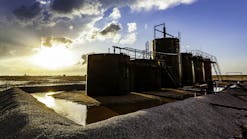Liquid flow of a process fluid into a vessel was visually confirmed. However a vortex-shedding flowmeter in the feed pipe measured zero flow. The flowmeter was removed from service and was found to function properly on the flow bench in the instrument shop. Which of the following problems could cause this issue to occur?
A. High temperature
B. High pressure
C. Wiring problem
D. Configuration problem
E. Composition change
F. Steam tracer off
Commentary
High pressure and high temperature should not affect the flow measurement — presuming the pressure and temperature limits of the flowmeter have not been violated. Therefore, Answer A and Answer B should not cause this problem. A number of wiring problems (Answer C) and configuration problems (Answer D) that could cause the flow (signal) to be zero could occur.
Liquid composition changes (Answer E) could also cause this problem to occur. In general, process conditions whereby the liquid becomes more viscous could cause Reynolds number to fall sufficiently to cause the vortex-shedding flowmeter to turn off and "measure" zero flow.
Surprisingly, turning a steam tracer off (Answer F) could also cause this problem to occur. In particular, turning off a steam tracer would reduce the liquid temperature and increase its viscosity. Increasing viscosity reduces Reynolds number that could cause the vortex-shedding flowmeter to turn off and "measure" zero flow.
Additional Complicating Factors
Liquids are typically assumed to have a constant viscosity at a given temperature. However some liquids are non-Newtonian, whereby their viscosity changes at a given temperature depending upon how the liquid is handled. For example, the apparent viscosity of some liquids (such as ketchup) is initially high, but tends to fall drastically once flow occurs. Non-Newtonian fluids are typically more difficult to measure.
David W. Spitzer, P.E., is a regular contributor to Flow Control. He has more than 30 years of experience in specifying, building, installing, startup and troubleshooting process control instrumentation. He has developed and taught seminars for over 20 years and is a member of ISA and belongs to the ASME MFC and ISO TC30 committees. Mr. Spitzer has written a number of books concerning the application and use of fluid handling technology, including the popular “Consumer Guide” series, which compares flowmeters by supplier. Mr. Spitzer is currently a principal in Spitzer and Boyes LLC, offering engineering, product development, marketing and distribution consulting for manufacturing and automation companies. He can be reached at 845 623-1830.

